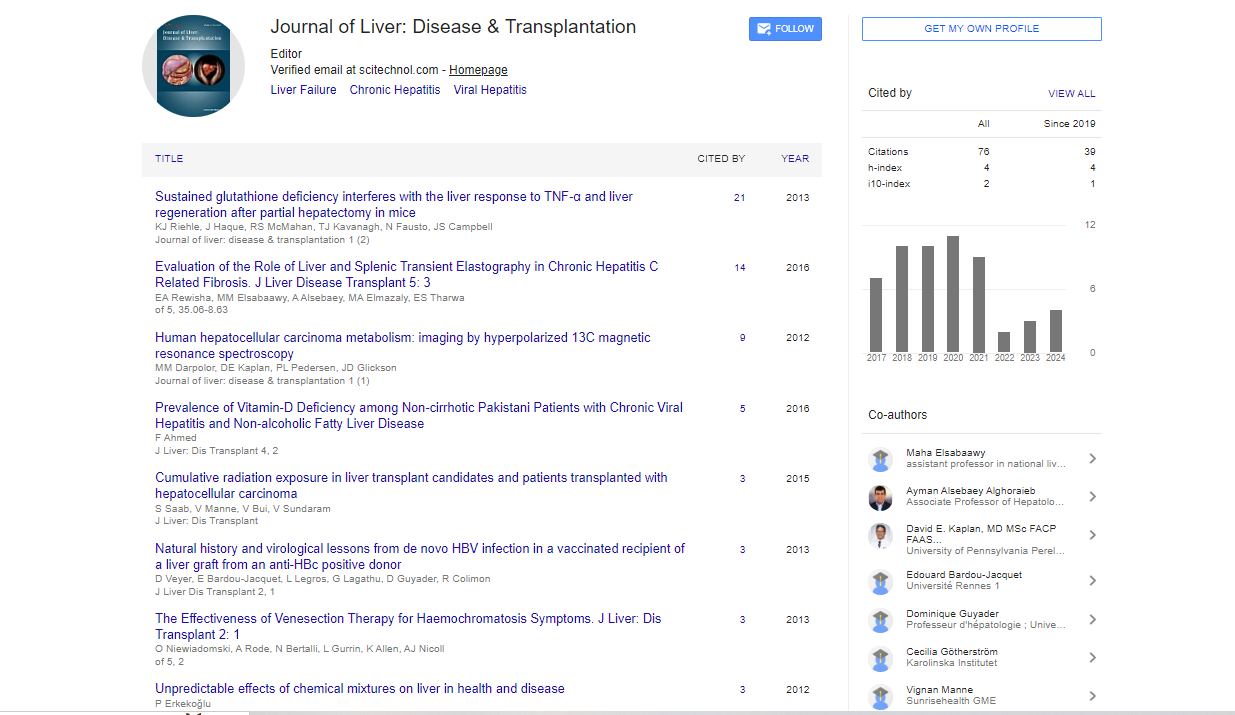Perspective, J Liver Disease Transplant Vol: 13 Issue: 1
Indications and Clinical Applications of Cholangiography in Advanced Hepatobiliary Imaging
Kale Maneera*
1Department of Surgery, St. James's Hospital, Dublin, Ireland
*Corresponding Author: Kale Maneera,
Department of Surgery, St. James's
Hospital, Dublin, Ireland
E-mail: maneka@tcd.ie
Received date: 12 February, 2024, Manuscript No. JLDT-24-135115;
Editor assigned date: 14 February, 2024, PreQC No. JLDT-24-135115 (PQ);
Reviewed date: 28 February, 2024, QC No. JLDT-24-135115;
Revised date: 06 March, 2024, Manuscript No. JLDT-24-135115 (R);
Published date: 13 March, 2024, DOI: 10.4172/2325-9612.1000257.
Citation: Maneera K (2024) Indications and Clinical Applications of Cholangiography in Advanced Hepatobiliary Imaging. J Liver Disease Transplant 13:1.
Description
In the field of hepatobiliary imaging, cholangiography stands as a cornerstone technique for diagnosing and managing a spectrum of hepatic and biliary tract disorders. Derived from the Greek words "cholē" (bile) and "grapho" (to write), cholangiogram literally translates to "writing bile." It encompasses a variety of imaging modalities aimed at visualizing the bile ducts, offering invaluable insights into the anatomy, pathology, and function of the biliary system. Cholangiogram techniques can be broadly categorized into two main modalities: Direct and indirect. Direct cholangiography involves the introduction of contrast media directly into the biliary system through various routes, facilitating real-time visualization.
Endoscopic Retrograde Cholangiopancreatography (ERCP) and Percutaneous Transhepatic Cholangiography (PTC) represent the principal methods of direct cholangiography. Conversely, indirect cholangiography relies on the physiological secretion and excretion of contrast agents by the hepatobiliary system, visualized through imaging modalities such as Magnetic Resonance Cholangiopancreatography (MRCP) and Computed Tomography Cholangiography (CTC). Endoscopic Retrograde Cholangiopancreatography (ERCP) remains a cornerstone in the armamentarium of interventional gastroenterology. Employing a flexible endoscope, contrast medium is injected into the bile ducts via the ampulla of Vater, enabling high-resolution fluoroscopic visualization. ERCP not only facilitates diagnostic cholangiography but also offers therapeutic interventions such as stone extraction, stent placement, and tissue sampling.
Percutaneous Transhepatic Cholangiography (PTC) serves as a valuable alternative or adjunct to ERCP, particularly in cases where endoscopic access is challenging or unsuccessful. Under radiological guidance, a needle is advanced percutaneously into the biliary tree, followed by contrast injection for imaging. PTC is particularly advantageous in the evaluation of complex biliary strictures, intrahepatic ductal pathologies, and post-surgical complications. Magnetic Resonance Cholangiopancreatography (MRCP) harnesses the inherent magnetic properties of hydrogen nuclei to generate detailed images of the biliary and pancreatic ducts. Without the need for contrast injection or ionizing radiation, MRCP offers a non-invasive and versatile imaging modality, ideal for evaluating biliary obstruction, choledocholithiasis, and biliary anatomy prior to surgery or intervention.
Computed Tomography Cholangiography (CTC) utilizes computed tomography imaging to delineate the biliary system following the administration of intravenous or oral contrast agents. With rapid acquisition times and high spatial resolution, CTC provides comprehensive visualization of the biliary tree, aiding in the diagnosis of biliary tract malignancies, inflammatory conditions, and postoperative complications. The indications for cholangiogram encompass a broad spectrum of hepatobiliary pathologies, ranging from benign to malignant conditions. Cholangiography plays a pivotal role in the diagnostic workup, treatment planning, and therapeutic interventions for various biliarydisorders. Obstructive jaundice represents one of the primary indications for cholangiogram, necessitating the delineation of the site and etiology of biliary obstruction. Whether caused by choledocholithiasis, malignancy, strictures, or benign biliary diseases, cholangiography aids in identifying the underlying pathology and guiding subsequent management strategies. Gallstone-related disorders, including choledocholithiasis and Mirizzi syndrome, often require cholangiography for accurate diagnosis and therapeutic intervention. ERCP with stone extraction or lithotripsy remains the mainstay of treatment for choledocholithiasis, offering a minimally invasive approach to stone clearance. Biliary strictures, whether benign or malignant, pose diagnostic and therapeutic challenges necessitating cholangiographic evaluation. PTC and ERCP play pivotal roles in characterizing the nature and extent of strictures, facilitating tissue sampling for histological diagnosis, and enabling therapeutic interventions such as stent placement or balloon dilatation.
Primary Sclerosing Cholangitis (PSC), a chronic inflammatory disorder of the biliary tree, often necessitates cholangiographic evaluation for disease staging and surveillance. MRCP serves as the imaging modality of choice for assessing disease extent, detecting biliary strictures, and monitoring disease progression in patients with PSC. Recent advancements in cholangiogram techniques have revolutionized the field of hepatobiliary imaging, offering enhanced diagnostic accuracy, safety, and patient outcomes. The emergence of digital cholangioscopy has enabled direct visualization of the biliary mucosa, facilitating targeted biopsies and therapeutic interventions in cases of indeterminate biliary strictures or intraductal pathology. Contrast-Enhanced Ultrasound (CEUS) represents a promising modality for dynamic evaluation of biliary flow and vascularity, particularly in cases of suspected biliary obstruction or postoperative complications. With the advent of microbubble contrast agents, CEUS offers real-time assessment of biliary patency and perfusion without the need for ionizing radiation or nephrotoxic contrast agents. Artificial Intelligence (AI) and machine learning algorithms hold immense potential in enhancing the diagnostic accuracy and efficiency of cholangiogram interpretation. By leveraging large datasets and pattern recognition algorithms, AI algorithms can assist radiologists and gastroenterologists in detecting subtle biliary abnormalities, predicting treatment response, and stratifying patient prognosis.
Conclusion
In conclusion, cholangiogram remains an indispensable tool in the armamentarium of hepatobiliary imaging, offering unparalleled insights into the anatomy, pathology, and function of the biliary system. From its humble origins to contemporary advancements, cholangiography continues to evolve, driven by innovation, technological advancements, and a relentless pursuit of excellence in patient care. As we navigate the complexities of hepatobiliary disease, cholangiogram stands as a beacon of light, guiding clinicians and researchers towards a deeper understanding of the intricate interplay between the liver, bile ducts, and beyond.
 Spanish
Spanish  Chinese
Chinese  Russian
Russian  German
German  French
French  Japanese
Japanese  Portuguese
Portuguese  Hindi
Hindi 